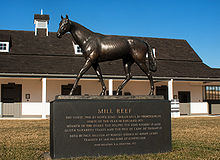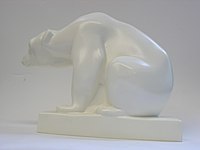John Skeaping
John Skeaping | |
|---|---|
| Born | John Rattenbury Skeaping 9 June 1901 South Woodford, England |
| Died | 5 March 1980 (aged 78) |
| Alma mater | |
| Known for | Sculpture |
| Spouse | |
John Rattenbury Skeaping, RA (9 June 1901 – 5 March 1980) was an English sculptor and equine painter and sculptor. He designed animal figures for Wedgwood, and his life-size statue of Secretariat is exhibited at the National Museum of Racing and Hall of Fame.
Biography
[edit]


Born in South Woodford, Essex, Skeaping was the eldest son of the painter Kenneth Mathieson Skeaping, and studied at Goldsmiths College in London, the Central School of Arts and Crafts between 1917 and 1919, and later at the Royal Academy until 1920.[1][2] In 1924, he won the British Prix de Rome and its scholarship to the British School at Rome.̣[1]
Skeaping was the first husband of the sculptor Barbara Hepworth, whom he met while studying in Rome.[2] They married in May 1925 in Florence.[3] The couple had a joint exhibition in 1928 at the Alex Reid and Lefevre Gallery in Glasgow.[2] They had a son, Paul Skeaping, who was born in 1929 and died in 1953 in Thailand.[4] Hepworth and Skeaping began divorce proceedings in 1931;[5] the divorce was finalised in March 1933.[3]
He was a member of the London Group from 1928 to 1934, joined the Seven and Five Society in 1932, and later, after World War II, worked for a period in Mexico.[1][2] During the War, Skeaping had been commissioned by the War Artists' Advisory Committee to produce a portrait bust.[6][7] He was elected to the Royal Academy in 1960, having exhibited there since 1922.[1] Skeaping wrote several books on drawing and an autobiography, Drawn from Life was published in 1977.[1] From 1948, he taught sculpture at the Royal College of Art and was professor of sculpture there from 1953 to 1959.[1][2]
Skeaping later lived in Devon near the village of Chagford and moved to the Camargue, France in 1959. A BBC documentary One Pair of Eyes – John Skeaping (1970) directed by David Cobham was produced for BBC TV during Skeaping's time there.[8] The Tate Gallery owns eight works by Skeaping.[9] His work was also part of the painting event in the art competition at the 1948 Summer Olympics.[10] Two life-size racehorses by Skeaping were cast by H.H. Martyn & Co.,[11] Hyperion in 1962 and Chamossaire in 1966. The statue of Hyperion is now located in the National Horse Racing Museum, while that of Chamossaire is in Snailwell.
Portrait sculptures
[edit]Marble heads dating from London, c. 1927[12] of Barbara Hepworth by Skeaping, and of Skeaping by Hepworth are documented by photograph in the Retrospective catalogue, but are both believed lost. A stone head of Arthur Lett-Haines dates from 1933, when Skeaping was living in the artists' colony at the house of Sir Cedric Morris after the breakup of his marriage to Hepworth. A bronze sketch (1978)[13] of Skeaping exists by Sally Arnup.
Animals for Wedgwood
[edit]-
Monkeys
-
Bison
-
Polar bear
References
[edit]- ^ a b c d e f David Buckman (2006). Artists in Britain Since 1945 Vol 2, M to Z. Art Dictionaries Ltd. ISBN 0-953260-95-X.
- ^ a b c d e Frances Spalding (1990). 20th Century Painters and Sculptors. Antique Collectors' Club. ISBN 1-85149-106-6.
- ^ a b "Barbara Hepworth: Biography". Hepworth Estate. Retrieved 16 March 2022.
- ^ "P. Skeaping Died: Feb 1953 BillionGraves Record".
- ^ "Divorce Court File: 1565. Appellant: Jocelyn Barbara Skeaping. Respondent: John Rattenbury Skeaping..." The National Archives. 1931. Retrieved 16 March 2022.
- ^ Brian Foss (2007). War Paint: Art, War, State and Identity in Britain, 1939–1945. Yale University Press. ISBN 978-0-300-10890-3.
- ^ Imperial War Museum. "War artists archive, John Skeaping". Imperial War Museum. Retrieved 31 March 2020.
- ^ BFI.org
- ^ "John Skeaping 1901–1980 Artworks". Tate. Retrieved 22 November 2020.
- ^ "John Skeaping". Olympedia. Retrieved 22 August 2020.
- ^ John Whitaker (1985). "The Best". p. 133.
- ^ John Skeaping 1901–80: A Retrospective, exh. cat., Arthur Ackermann and Son, London, 1991 p. 7.
- ^ John Skeaping 1901–80: A Retrospective, exh. cat., Arthur Ackermann and Son, London, 1991 p. 67.
Further reading
[edit]- 2011: The Sculpture of John Skeaping, Jonathan Blackwood (Lund Humphries); ISBN 978-0-85331-931-3
External links
[edit]- 44 artworks by or after John Skeaping at the Art UK site
- 1901 births
- 1980 deaths
- 20th-century British sculptors
- English sculptors
- English male sculptors
- Equine artists
- British modern sculptors
- Prix de Rome (Britain) winners
- Royal Academicians
- People from Essex
- Alumni of the Central School of Art and Design
- Alumni of the Royal Academy Schools
- Alumni of Goldsmiths, University of London
- Olympic competitors in art competitions
- Skeaping family



